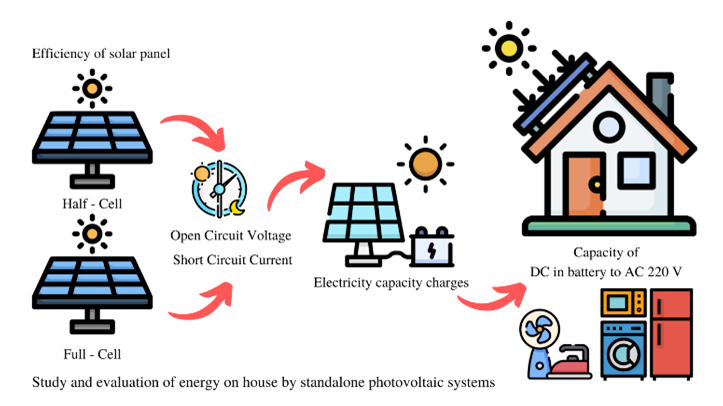Study and evaluation of energy on the house by standalone photovoltaic systems of half-cell and full cell types
DOI:
https://doi.org/10.55674/snrujst.v14i3.247406Keywords:
Selected:Solar energy, Renewable Energy, Solar panelAbstract
This research aimed to investigate the effectiveness and performance of standalone photovoltaic systems of the half-cell and full-cell types. In Phetchabun province, it requires 8 hours of sunlight per day between the hours of 8:00 A.M. and 4:00 P.M.. Open circuit voltage, short circuit current, DC, and AC power are continually recorded for 62 days in July and August 2020. According to the results of the solar panel efficiency test, the full and haft cell solar panels' actual efficiencies are 89.13 and 89.04% of the manufacturer's maximum power, respectively. The power generating efficiency of full-cell and half-cell types of panels was considerably different at 95% confidence. The power of 307.5 and 307.9 W for full and half-cell solar panels. By using two 345 W solar panels connected in parallel, it can produce an average voltage and current of 25.40 V and 21.62 Ah respectively, and when charged to a 100 Ah 24 V battery for 8 hours it can use electrical appliances including 350, 450, 550, and 650 W.
References
Energy Statistics of Thailand 2018, http:// www.eppo.go.th/index.php/en/en-energyst
atistics/electricity-statistic, 31 December 2021.
The Solar Map, http://weben.dede.go.th/we
bmax/, 25 November 2021.
Thailand Power Development Plan 2015 –2036 (PDP 2015); www.egat.co.th/en/imag
es/about-egat/PDP2015_Eng.pdf, 11 April 2021.
Alternative Energy Development Plan
– 2036 (AEDP 2015), www.eppo.go.th /images/POLICY/ENG/ AEDP 2015ENG.pdf
S. Tongsopit. Thailand’s feed-in tariff for residential rooftop solar PV systems: Progress
so far, Energy Sustain. V. 29 (2015) 127–134.
Solar-Cells, http://chemistryexplained.com/ Ru-Sp/Solar-Cells.html, 25 December 2021
S.P. Philipps, A.W. Bett, K. Horowitz,
S. Kurtz, Current status of concentrator photovoltaic (CPV) technology, National Renewable Energy Lab. (NREL), Golden, CO (United States), United States, 2015.
V.V. Tyagi, N.A. Rahim, N.A. Jeyraj,
A. L. Selvaraj, “Progress in solar PV technology: Research and achievement, Renew. Sust. Energ. Rev. 20 (2013) 443 − 461.
A. Attakorn, K. Itsarapong, K. Tanongkiat, Performance prediction of poly–crystalline solar cell module under real practice, Engng.J.CMU. 22(3) (2015) 87 − 93.
I. Mustapha, M.K. Dikwa, B.U. Musa,
M. Abbagana, Performance evaluation of polycrystalline solar photovoltaic module in weather conditions of Maiduguri, Nigeria, Arid Zone. J. Eng. Technol. Environ. 9 (2013) 69 − 81.
P. Eakkapun, K. Kanaporn, I. Ukkarin, Efficiency and performance analysis of a 300 kW grid-tied solar power generation system, The 3rd KU SRC Annual Conference, Kasetsart University. 30 August 2018, 95 – 104.
L.M. Ayompe, A. Duffy, S.J. McCormack, M. Conlon, Measured performance of a 1.72 kW rooftop grid connected photovoltaic system in Ireland, Energy Convers. Manag. 52(2) (2011) 816 – 825.
R. Sharma, S. Goel, Performance analysis of a 11.2 kWp roof top grid–connected PV system in Eastern India, Energy Rep. 3 (2017) 76 – 84.
S. Guo, J.P. Singh, I.M. Peters, A.G. Aberle, T.M. Walsh, A quantitative qnalysis of photovoltaic modules using halved cells. Int. J. Photoenergy, 2013 (2013) 739374.
H. Hanifi, J. Schneider, J. Bagdahn, Reduced shading effect on half-cell modules – measurement and simulation, In 31st European Photovoltaic Solar Energy Conference and Exhibition, Hamburg, Germany. 2015, 2529 – 2533.
M. Teerapat, D. Parnjit, Optimal battery energy storage system for pv grid connector for customer with time–of– use tariff, Int. J. Energy Res. 12(2) (2015) 75 – 94
T. Pairote, Analysis of the relationship between solar power and rated load for installation of stand–alone PV system. JERMUTT. 16(2) (2018) 95 – 105.
S. Jain, V. Sonti, A highly efficient and reliable inverter configuration based cascaded multilevel inverter for PV systems, IEEE Trans.
Ind. Electron. 64(4) (2016) 2865 – 2875.

Downloads
Published
How to Cite
Issue
Section
License
Copyright (c) 2022 SNRU Journal of Science and Technology

This work is licensed under a Creative Commons Attribution-NonCommercial-NoDerivatives 4.0 International License.








